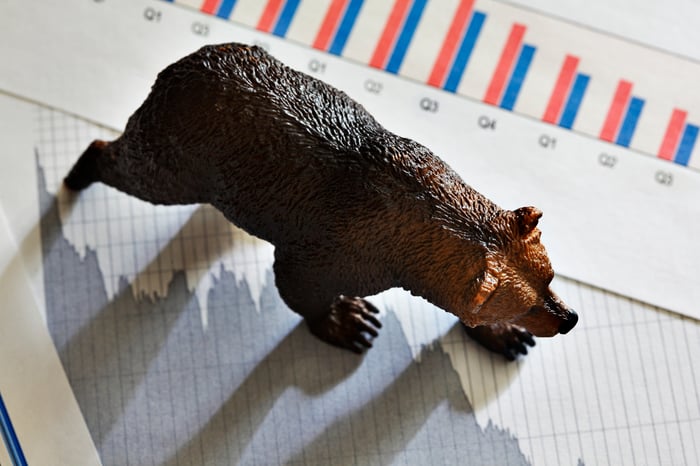Until you are a short-seller or had been closely invested in vitality shares, there is a good probability you, together with a lot of the funding group, took it on the chin in 2022. When the curtain closed, the long-lasting Dow Jones Industrial Common (^DJI 2.13%), broad-based S&P 500 (^GSPC 2.28%), and growth-focused Nasdaq Composite (^IXIC 2.56%), ended decrease by 9%, 19%, and 33%, respectively. It was the worst efficiency for the three main U.S. inventory indexes since 2008.
However a brand new 12 months brings new hope, new alternatives, and naturally, new prognostications. What follows are 12 inventory market predictions for 2023 overlaying all the things from the efficiency of particular high-profile shares to expectations for the U.S. economic system.

Picture supply: Getty Photographs.
1. We’ll nonetheless be in a bear market by 12 months’s finish
Let’s begin with essentially the most front-and-center query on buyers’ minds: What’s going to the broader market do in 2023? Primarily based on what historical past tells us, I would opine that Wall Avenue will nonetheless be firmly in a bear market by the tip of the 12 months. Although it is attainable the indexes might finish marginally larger, a brand new bull market will not be declared.
Usually, the Federal Reserve lowers rates of interest to assist out an ailing economic system and/or inventory market. However with the nation’s central financial institution tackling traditionally excessive inflation, charge cuts are nonetheless a great distance off. It normally takes the S&P 500 within the neighborhood of a 12 months to discover a backside as soon as charge cuts start.
2. The U.S. will fall right into a recession in 2023
To considerably construct on the primary prediction, it would not be a shock to see the U.S. economic system dip right into a recession this 12 months. The telltale indicator {that a} recession is probably going is the prolonged inversion of the Treasury bond yield curve. By “inversion,” I imply long-term-maturing bonds having a decrease yield than short-term-maturing bonds. Usually, the yield curve slopes up and to the appropriate, with longer-dated bonds sporting larger yields.
Though not each yield curve inversion is adopted by a recession, each recession since World Struggle II has been preceded by a yield curve inversion. The magnitude of the inversion between the 2-year and 10-year Treasury bonds in 2022 was the most important in 4 a long time.
10-2 12 months Treasury Yield Unfold knowledge by YCharts.
3. The rate of interest yield curve will reverse its inversion in the course of the second-half of the 12 months
On the opposite aspect of the aisle, I absolutely anticipate the yield curve inversion to appropriate itself earlier than crossing the proverbial end line into 2024. Wall Avenue and buyers are usually forward-looking, and there must be higher readability of the trail ahead for the U.S. economic system and Federal Reserve financial coverage as we close to the tip of the 12 months.
Arguably the largest beneficiary of the yield curve reversing its inversion could be the mortgage actual property funding belief (REIT) business. As short-term borrowing prices fall and/or long-term yields rise, mortgage REITs equivalent to Annaly Capital Administration and AGNC Funding ought to profit from beefier web curiosity margins.
4. The U.S. inflation charge ends the 12 months far under expectations
If there’s a vibrant spot to attainable financial weak spot in 2023, it is that the U.S. inflation charge can extra rapidly again off the 40-year excessive of 9.1% registered in June 2021.
Particularly, recessions are inclined to hit vitality commodities fairly laborious. With crude oil and pure gasoline each hovering final 12 months, a major decline in a single or each commodities might considerably scale back the inflation charge.
However do not get your hopes up — a fast discount within the inflation charge is unlikely to change Fed financial coverage. Fed Chair Jerome Powell has been clear that the central financial institution is keen to take a seat on larger charges for an extended interval to make sure inflation is nicely beneath management.

Picture supply: Getty Photographs.
5. Healthcare would be the top-performing sector in 2023
Final 12 months, healthcare shares had been blended, with COVID-19-driven firms struggling because the worst of the pandemic was put into the rearview mirror. In 2023, anticipate healthcare shares to shine as their defensive nature and customarily enticing valuations come into play.
For instance, irrespective of how poorly the U.S. economic system or inventory market carry out, we won’t management once we get sick or what ailment(s) we develop. This creates regular demand for pharmaceuticals, medical units, and quite a lot of healthcare companies in any financial setting. In different phrases, healthcare shares could possibly be simply what the physician ordered throughout heightened volatility for equities.
6. Gold-mining shares might be among the many best-performing industries
By way of industries, gold shares can regain their luster in 2023 and vastly outpace the broader market.
There are a variety of potential tailwinds for treasured metals and mining shares this 12 months, together with financial uncertainty, traditionally excessive inflation (at the least in the course of the early portion of the 12 months), and a number of years of unabated money-printing by the U.S. Treasury, which make laborious belongings like gold seem all of the extra enticing.
One thing else to think about is that gold shares are inclined to carry out their greatest in the course of the very early levels of a bull market. Whereas, for my part, a bull market is unlikely to materialize in 2023, buyers could place themselves for a bull market in gold shares nicely forward of an official bull market within the Dow, S&P 500, and Nasdaq Composite.
7. Vitality shares will battle following a robust 12 months
On the flipside, vitality shares might have a difficult 2023. As I famous earlier, if a recession had been to materialize within the U.S. or globally, demand for vitality commodities would decline, which is unhealthy information for crude oil and pure gasoline spot costs.
The opposite consideration is that oil and gasoline costs already pulled again within the second-half of 2022 with out a lot of a dip within the share costs of oil and gasoline shares. When buyers smart as much as the disassociation between vitality commodity costs and oil and gasoline drillers over the previous couple of months, the end result could possibly be ugly.
8. Apple will fall under $100
Final week, the most important publicly traded firm by market cap within the U.S., Apple (AAPL 3.68%), fell under a $2 trillion valuation and touched its lowest share worth ($124) since June 2021. In 2023, I would search for Apple to return to double-digits and fall under $100.
Though Apple’s companies phase stays sturdy and the corporate accounts for a majority of U.S. smartphone market share, Apple’s development charge has slowed significantly. The iPhone 14 not providing quite a lot of differentiation from its predecessor, together with abroad provide chain challenges, could possibly be enjoying a job in that slowdown.
Moreover, quickly rising rates of interest imply Apple has misplaced entry to a budget debt it will often use to speed up share buybacks. With simply 3% gross sales development anticipated in 2023 (per Wall Avenue), a price-to-earnings ratio of almost 21 merely is not that low cost.
9. Toyota will shut out 2023 because the world’s largest automaker by market cap
A bit of greater than a 12 months in the past, electric-vehicle (EV) producer Tesla (TSLA 2.46%) pushed north of a $1 trillion valuation, which was greater than each publicly traded legacy automaker mixed! As of the closing bell on Jan. 4, Tesla had retraced to a $409 billion market cap. By the tip of 2023, I anticipate Tesla to have taken a again seat to Toyota Motor in market cap (at the moment $187 billion).
Buyers are waking up the conclusion that Tesla is not resistant to the availability chain-, inflationary-, and demand-based headwinds impacting the auto business. They’re additionally coming to phrases with Elon Musk being an plain legal responsibility for Tesla in quite a lot of methods.
10. China shares will vastly outperform U.S. shares
It has been fairly a while since China shares handily outperformed U.S. equities. My considering is that adjustments in 2023.
Arguably the largest problem for China for almost three years has been its dealing with of the COVID-19 pandemic. The nation’s zero-COVID technique crippled provide chains and despatched provinces into seemingly unpredictable lockdowns. With that technique being deserted and China successfully pulling off the Band-Support, short-term ache (i.e., widespread COVID-19 an infection) may give solution to severe financial development and alternative within the second-half of 2023.
It is a recipe for low cost Chinese language development shares like Baidu and JD.com to thrive.
US Median Worth for Present Single Household House knowledge by YCharts.
11. U.S. house costs fall as a lot as 20%
The brand new 12 months is unlikely to be sort to the housing business. Greater than a decade of declining mortgage charges left homebuyers and refinancers successfully spoiled. However with the 30-year mortgage charge skyrocketing final 12 months to a 16-year excessive of round 7%, the need to purchase properties and refinance slowed to a crawl. Housing is a provide and-demand-driven business. If demand plummets, you’ll be able to nearly definitely anticipate costs to observe. I imagine house costs might drop 20% over the subsequent 12 months.
The silver lining right here is that if U.S house costs fall 20%, demand ought to start to select up — at the least from money consumers. This’ll preserve the housing business from struggling a crash much like 2008.
12. A monetary disaster will unfold (greatest guess: subprime auto loans)
Final however not least, I do anticipate some kind of monetary disaster or contagion occasion to materialize in 2023. However provided that crises and contagion occasions aren’t all that unusual, this is not precisely a daring prediction.
What’s a daring prediction is specifying the place the disaster will originate. My greatest guess is amongst subprime debtors within the auto mortgage house. As of October 2022, 5.13% of subprime debtors had been at the least 61 days delinquent on their auto funds, which is up from 3.76% in October 2021. Increased inflation, the prospect of a better unemployment charge in 2023, and the tip of pandemic-related monetary help packages, are all potential headwinds for people with poor credit score scores within the new 12 months.
Whereas a subprime auto mortgage credit score disaster would pale compared to the monetary disaster in 2008, it nonetheless could be very unhealthy information for financial institution shares and the auto business.
from Stock Market News – My Blog https://ift.tt/pWuyv5m
via IFTTT





No comments:
Post a Comment